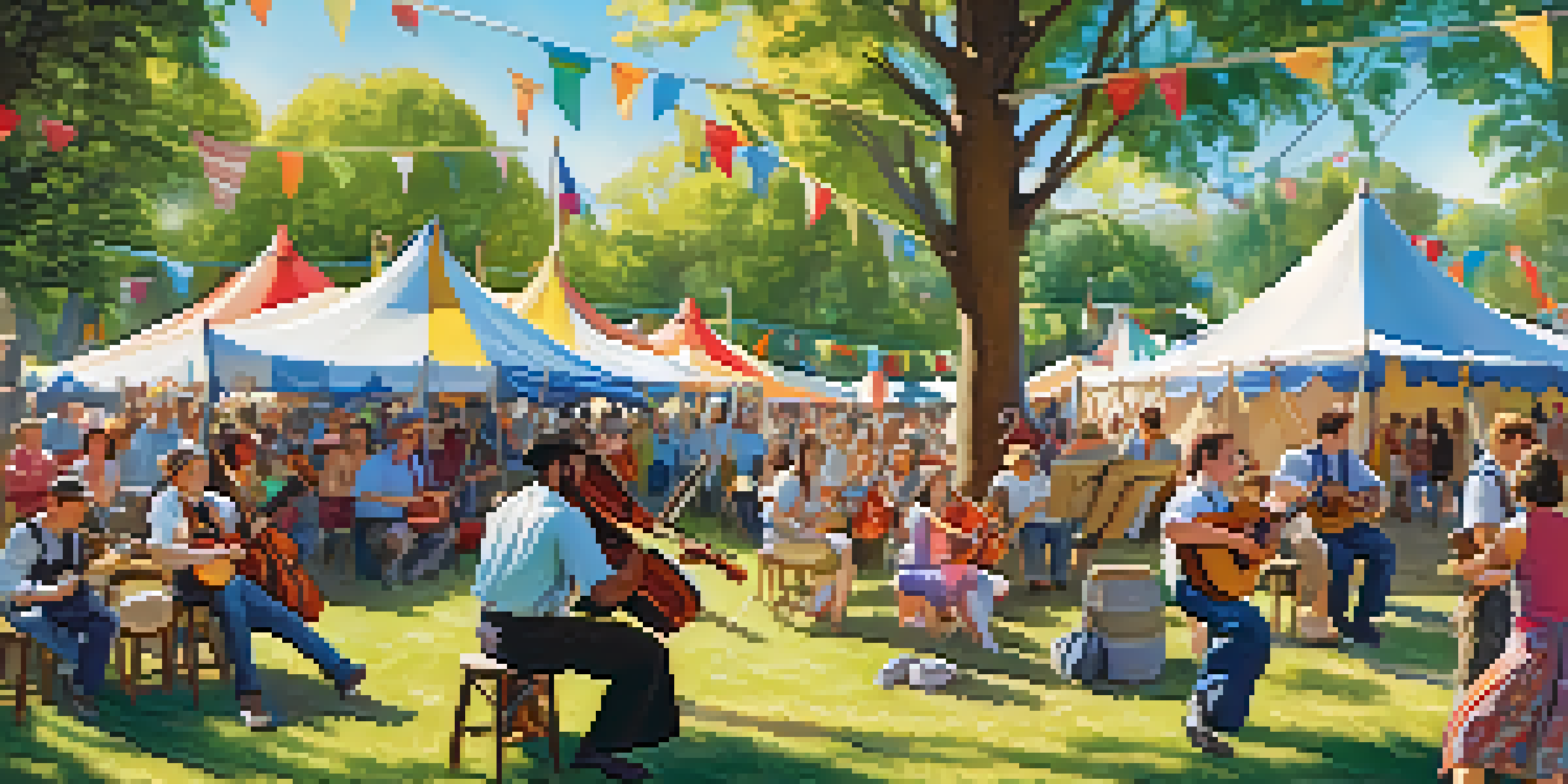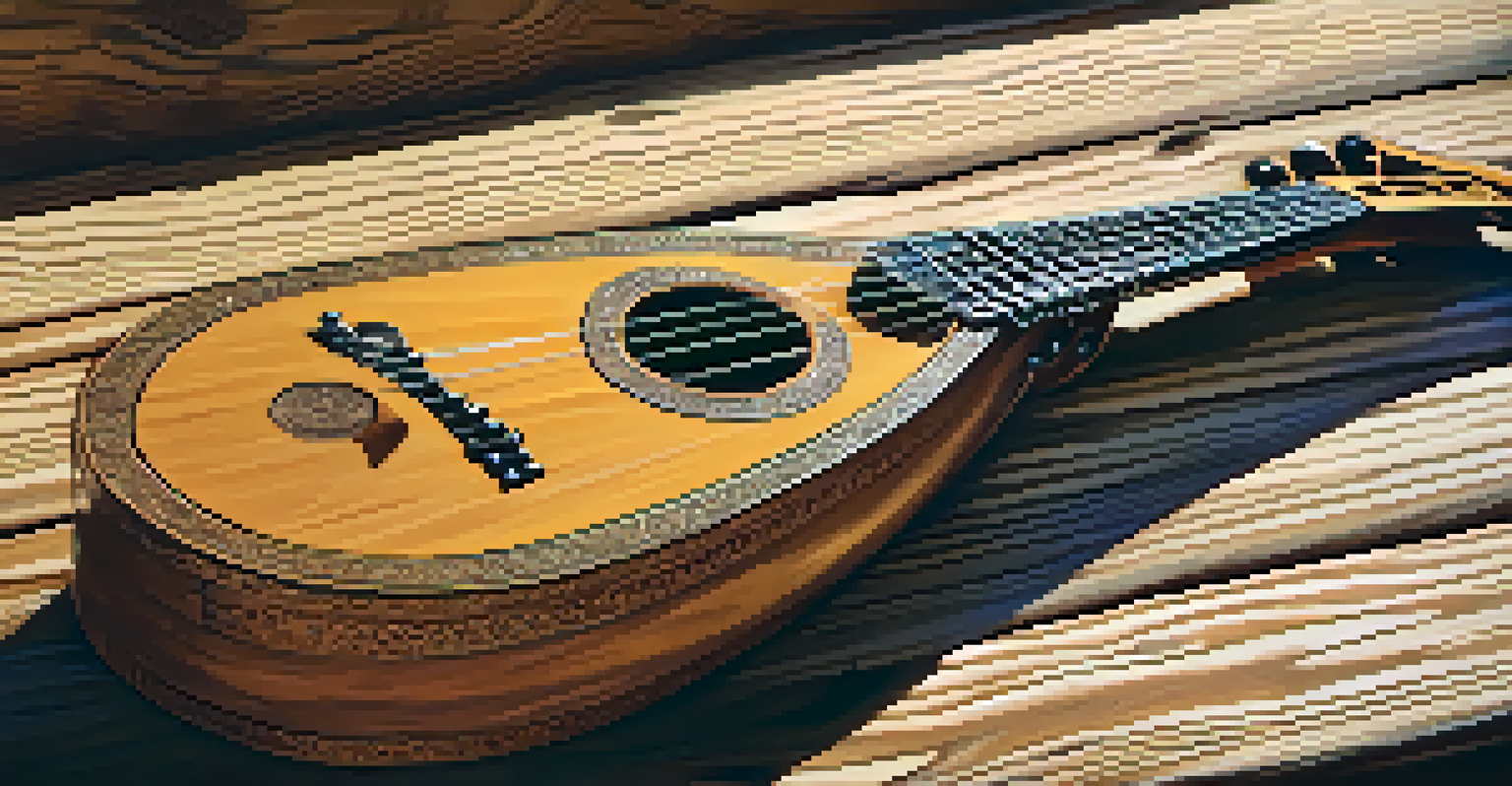The Role of Folk Music in Preserving Cultural Heritage

Understanding Folk Music and Its Roots
Folk music, often seen as the soundtrack of everyday life, has deep roots in the traditions of a community. It reflects the experiences, struggles, and joys of people, often passed down through generations. Think of it as a living history book, where each song tells a story that connects the past with the present. Through melodies and lyrics, folk music encapsulates the essence of cultural identity.
Folk music is the original music of the people, and it is the song of the heart and the voice of the soul.
This genre often encompasses various styles and instruments unique to different regions. For instance, the use of the banjo in American folk music or the lute in Middle Eastern folk traditions highlights how geography influences sound. By embracing local instruments and dialects, folk music serves as a reminder of cultural diversity, celebrating what makes each community unique.
Moreover, folk music often evolves while still honoring its origins. New artists may reinterpret traditional songs, blending modern influences without losing the essence of the original. This adaptability ensures that folk music remains relevant, engaging newer generations while preserving its historical significance.
Folk Music as a Storytelling Medium
At its core, folk music is a powerful storytelling medium that encapsulates the narratives of a community. Each song often tells tales of love, loss, celebration, or hardship, allowing listeners to connect emotionally with the experiences shared. Imagine sitting around a campfire, where a musician recounts tales of ancestors through song—this experience fosters a sense of belonging and continuity.

These stories often reflect the values, beliefs, and customs of a culture, serving as a bridge between generations. For example, songs about harvests not only celebrate agricultural life but also pass on knowledge about seasonal changes and community unity. In this way, folk music acts as an oral history, preserving the collective memory of a people.
Folk Music as Community Storytelling
Folk music serves as a powerful medium for storytelling, connecting communities through shared narratives of love, loss, and celebration.
Additionally, folk music can highlight social issues and inspire change. Many folk songs have emerged as anthems for movements, conveying messages of resistance and hope. This aspect of storytelling not only entertains but also educates, ensuring that the lessons of the past continue to resonate.
The Role of Folk Music in Identity Formation
Folk music plays a crucial role in shaping cultural identity, allowing individuals to connect with their heritage. When people engage with folk music, they often find a sense of pride in their roots and shared history. This connection can be likened to wearing a family heirloom—it's a tangible reminder of where one comes from and the stories that have shaped their existence.
Music is the universal language of mankind.
For immigrants and diasporic communities, folk music can be a vital link to their homeland. It provides a way to maintain cultural practices and values, fostering a sense of belonging even in a foreign land. Through community gatherings and celebrations, these songs become a way to preserve traditions while adapting to new environments.
Furthermore, folk music serves as an educational tool for younger generations. By teaching children traditional songs, families pass down cultural knowledge that might otherwise be lost. This intergenerational transmission reinforces identity and instills a sense of responsibility to honor one’s cultural heritage.
Folk Music in Community Building
Community gatherings centered around folk music foster social bonds and collective identity. Events like folk festivals, sing-alongs, or local concerts create spaces where people come together to celebrate their shared culture. These gatherings resemble a potluck dinner—everyone brings their unique flavor, enriching the communal experience.
Moreover, folk music encourages collaboration and participation. Community members often take part in creating and sharing music, which strengthens relationships and builds a sense of ownership over cultural traditions. This participatory aspect creates a vibrant atmosphere, where everyone feels valued and included.
Cultural Identity and Heritage
Engaging with folk music fosters a sense of pride in cultural heritage, allowing individuals to connect with their roots and pass traditions to future generations.
In times of crisis, folk music can also serve as a source of comfort and resilience. Communities often turn to their musical traditions to unite and heal, singing songs that resonate with their shared experiences. This collective expression of feelings not only reinforces community ties but also provides a platform for hope and healing.
Challenges Facing Folk Music Today
Despite its significance, folk music faces several challenges in the modern world. Globalization has led to the homogenization of cultures, often overshadowing local musical traditions. It's akin to ordering a burger at every fast-food chain—while convenient, it overlooks the rich variety and unique flavors of regional cuisines.
Additionally, younger generations may gravitate towards popular music genres, leading to a decline in interest in folk traditions. This shift can result in the loss of traditional knowledge and practices, creating a gap between generations. As folk music becomes less prominent, the stories and lessons embedded in these songs risk fading away.
However, there is hope for revitalization. Many artists are working to blend traditional folk music with contemporary styles, creating a fusion that appeals to younger audiences. By innovating while respecting the roots of folk music, there’s potential to inspire a new appreciation for cultural heritage.
The Role of Technology in Folk Music Preservation
Technology has transformed the way folk music is created, shared, and preserved. With the rise of social media and streaming platforms, musicians can now reach wider audiences, allowing traditional songs to find new fans. This accessibility is akin to opening a window to a vibrant world where diverse musical traditions can flourish.
Moreover, recording technology has made it easier to document folk music, ensuring that these valuable cultural expressions are not lost to time. Archival projects and digital libraries help preserve traditional songs, making them available for future generations. This effort resembles a digital time capsule—capturing the essence of a culture for years to come.
Challenges of Modernization
Despite its importance, folk music faces challenges from globalization and changing musical interests, risking the loss of traditional knowledge and practices.
However, while technology offers new opportunities, it also poses challenges. The commercialization of folk music can sometimes lead to the dilution of its authentic essence. It’s crucial for artists and communities to navigate this landscape thoughtfully, ensuring that the heart of folk music remains intact amid modern influences.
Celebrating Folk Music as a Cultural Treasure
In conclusion, folk music is more than just entertainment; it's a vital part of cultural heritage that deserves celebration. By recognizing and valuing its role in preserving traditions, identity, and community, we can ensure that these musical treasures endure. Think of folk music as a garden—nurtured with care, it can bloom beautifully across generations.
Communities and individuals can play a significant role in this celebration by participating in local events, supporting folk artists, and sharing these traditions with younger generations. It’s like passing down a family recipe—each generation adds their own twist, but the core ingredients remain the same.

Ultimately, embracing folk music means honoring the stories, struggles, and triumphs of those who came before us. As we sing, dance, and celebrate these songs, we create a shared legacy that enriches our cultural landscape and connects us all.